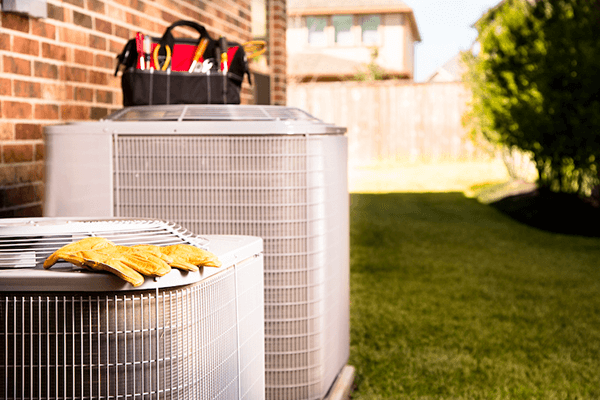Ductless Air Conditioners vs. Central Air Systems: Pros and Cons

If you’re in the market for a new air conditioner this season, you’ll have many options to consider. That’s because air conditioners are so popular in America. Almost 5 million new air conditioners were purchased in 2016 alone. Before you zero in on the right system for your home, you may want to decide between a central air conditioner and a ductless system.
Both central air and ductless systems have their own pros and cons for operation and features. Here’s how ductless and central air systems compare so you can make the right cooling decision for your home.
How Do Central Air Conditioners Work?
Central air conditioners have three primary parts: the outdoor unit, indoor unit, and ductwork.
The outdoor unit cools the indoor air while it is being recirculated around your home thru the furnace or air handler located in your mechanical area. The cooling is accomplished by means of an evaporator coil locating in the ducting by the furnace. The ductwork then disperses the conditioned air to every room of the home.
Since air conditioners come in a wide range of sizes and capacities, you’ll need an HVAC professional to determine the right size unit for your home.
Advantages of Central Air Conditioners
One of the biggest advantages of a central air conditioner is that it offers a complete cooling solution for your entire home. You’ll generally need just one system (some homes have separate systems for the upper level), and you can attach optional equipment to enhance your indoor air quality.
Unlike ductless systems, central air conditioners are generally controlled by one thermostat in your home. Though most older thermostats require manual operation, newer models have smart technology that can optimize your home’s cooling system with minimal user control.
Most smart thermostats allow you to adjust the temperature and check the settings from your smartphone, and some even offer energy reports.
If you have indoor air quality issues in your home, you can also invest in a number of HVAC add-ons to your central air system. Air purifiers, whole-home humidifiers, and energy-recovery ventilators work directly with your home’s central air system to keep the air fresh and clean in every room of your home.
Disadvantages of Central Air Conditioners
Central air conditioners offer limited ability to control temperature and comfort uniformly throughout the house. Most homes end up with hot or cold spots. While some systems can be zoned to allow separate thermostatic control, it is typically complicated, and not always as successful as desired.
How Do Ductless Air Conditioners Work?
Compared to central air conditioners, ductless systems, also known as mini-splits, are simpler systems. Ductless systems have just two parts: an outdoor unit and an indoor unit. As with central AC systems, piping and electrical wiring connects the indoor and outdoor units.
Each indoor unit cools a single room or an isolated space, and no ductwork is necessary. Ductless systems can match a single outdoor unit with a single indoor unit, or there are models that can allow several indoor units to be operated from a single outdoor unit.
Each interior unit comes with its own thermostat. This means that each area can be individually climate controlled.
Advantages of Ductless Systems
The biggest advantages of a ductless system are their flexible placement, their incredible efficiency, low noise levels indoors and out, and the high degree of comfort they provide.
Ductless systems can be a smart choice for new additions to your home and the areas of your home where it isn’t possible to install ductwork. In these cases, ductless systems can work well as supplements to central air conditioning systems (think ‘hot rooms’ located upstairs or at the ‘end of the line’).
Another huge advantage to ductless systems is that heat pump models can also provide heat. Many locations in the home that need cooling in the summer can also benefit from additional heat in the winter. Heat pump technology in ductless systems advanced at a fantastic pace. In fact, there are houses that are now being heated and cooled using only ductless systems.
When considering as a primary heat source, be sure to consult with an HVAC professional to ensure that any performance limitations have been discussed and addressed.
Disadvantages of Ductless Systems
Ductless systems can’t be installed in every application, and some people object to having a device mounted on the wall or recessed in the ceiling. Ductless systems are also not inexpensive. However, if they can be installed, their incredible efficiency and the reliable comfort they provide could balance out any objections.
Choosing the Right Air Conditioner for Your Home
Choosing your ideal cooling system depends on your goals. Is uniform comfort important? Do you need indoor air quality improvements? Is supplemental heat a concern? You’ll also want to consider your desire for certain types of technology, since central air conditioners tend to accommodate more indoor air quality add-ons and high-tech thermostats.
No matter what your home’s needs are, there are more options and better products on the market than ever before.
Once you’ve chosen the ideal system for your home, our experienced professionals can help ensure proper installation. And don’t forget to schedule preventive maintenance — both central air conditioners and ductless systems need an annual tune up to keep them running efficiently.
Ready to cool down with the ideal cooling system for your home? Contact our professional team to find a smart AC solution for your home today.




